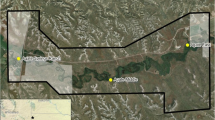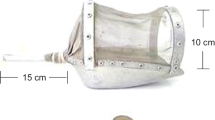Abstract
Sampling of individual stones to quantify benthic community structure has several advantages over traditional area-restricted samplers. Processing effort can be reduced, and density and error estimates that account for variation due to substratum heterogeneity and dispersion of organisms can be determined. Although the Doeg & Lake stone sampler is used to collect stream fauna from stones, our preliminary observations suggested that this sampler overestimated invertebrate density. A U net sampler is described that produces more accurate estimates of faunal density of individual stones. Performances of the U net and Doeg & Lake stone sampler were evaluated by collecting invertebrates from replicate cobbles (maximum diameter 128–256 mm) within a fourth-order stream and comparing respective estimates of invertebrate density, sample variance, and relative abundance. The Doeg & Lake sampler consistently overestimated invertebrate density compared with estimates from the U net. Differences in density estimates were due to increased disturbance of invertebrates due to placement of the Doeg & Lake sampler on the substratum compared to the U net technique. The number of taxa, species diversity (H') and sample variation collected from cobbles with the two samplers were similar. By isolating the fauna of individual stones; the U net produced accurate estimates of density and relative abundance of taxa. The U net sampler is an effective tool for collecting quantitative samples of stream macroinvertebrates because it can be used to quantify invertebrate faunas of large substrata where traditional, area-restricted samplers are ineffective.
Similar content being viewed by others
References
Boulton, A. J., G. M. Spangaro & P. S. Lake, 1988. Macroinvertebrate distribution and recolonization on stones subjected to varying degrees of disturbance: an experimental approach. Arch. Hydrobiol. 113: 551–576.
Doeg, T. & P. S. Lake, 1981. A technique for assessing the composition and density of the macroinvertebrate fauna of large stones. Hydrobiologia 80: 3–6.
Dixon, R. W. J. & F. J. Wrona, 1992. Life history and production of the predatory caddisfly Rhyacophila vao Milne in a spring-fed stream. Freshwat. Biol.: 27: 1–11.
Downing, J. A., 1979. Aggregation, transformation, and the design of benthos sampling programs. J. Fish. Res. Bd Can. 36: 1454–1463.
Graesser, A. & P. S. Lake, 1984. Diel changes in the benthos of stones and of drift in a southern Australian upland stream. Hydrobiologia 111: 153–160.
Kirk, R. E., 1982. Experimental design: procedures for the behavioral sciences. 2nd edn. Brooks/Cole Publ., USA. pp. 911.
Lake, P. S. & T. J. Doeg, 1985. Macroinvertebrate colonization of stones in two upland southern Australian streams. Hydrobiologia 126: 199–211.
Malmqvist, B. & C. Otto, 1987. The influence of substrate stability on the composition of stream benthos: an experimental study. Oikos 48: 33–38.
McAuliffe, J. R., 1984. Competition for space, disturbance, and the structure of a benthic stream community. Ecology 65: 894–908.
McElhone, M. J. & R. W. Davies, 1983. The influence of rock surface area on the microdistribution and sampling of attached riffle-dwelling Trichoptera in Hartley Creek, Alberta. Can. J. Zool. 61: 2300–2304.
Morin, A., 1985. Variability of density estimates and the optimization of sampling programs for stream benthos. Can. J. Fish. aquat. Sci. 42: 1530–1534.
Peckarsky, B. L., 1991. Habitat selection by stream-dwelling predatory stoneflies. Can. J. Fish. aquat. Sci. 48: 1069–1076.
Pringle, J. D., 1984. Efficiency estimates for various quadrat sizes used in benthic sampling. Can. J. Fish. aquat. Sci. 41: 1485–1489.
Rader, R. B. & J. V. Ward, 1990. Diel migration and microhabitat distribution of a benthic stream assemblage. Can. J. Fish. aquat. Sci. 47: 711–718.
Sheldon, A. L., 1979. Cost and precision in a stream sampling program. Hydrobiologia 111: 147–152.
Waters, T. F., 1969. Invertebrate drift-ecology and significance to stream fishes. Proceedings of the symposium on salmon and trout in streams, University of British Columbia, Vancouver, British Columbia, Canada: 121–134.
Wrona, F. J., P. Calow, I. Ford, L. Maltby & D. J. Baird, 1986. Estimating the abundance of stone-dwelling organisms: a new method. Can. J. Fish. aquat. Sci. 43: 2025–2035.
Wrona, F. J. & R. W. J. Dixon, 1991. Group size and predation risk: a field analysis of encounter and dilution effects. Am. Nat. 137: 186–201.
Zar, J. H., 1984. Biostatistical analysis. 2nd edn. PrenticeHall Publ., USA.
Author information
Authors and Affiliations
Rights and permissions
About this article
Cite this article
Scrimgeour, G.J., Culp, J.M. & Glozier, N.E. An improved technique for sampling lotic invertebrates. Hydrobiologia 254, 65–71 (1993). https://doi.org/10.1007/BF00014309
Received:
Revised:
Accepted:
Issue Date:
DOI: https://doi.org/10.1007/BF00014309




